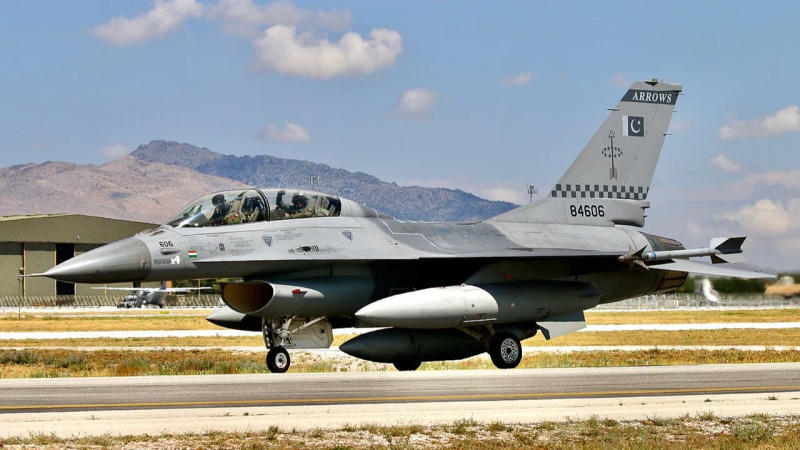Published 19:10 IST, December 17th 2023
Friendly fire or strategic plot? Unraveling the mystery behind Pakistan's1987 F-16 shootdown
In 1987, a Pakistan Air Force F-16 gihter jet was lost in an encounter with Afghan aircraft, revealing a case of friendly fire.

In a surprising turn of events, an F-16 belonging to the Pakistan Air Force was lost during an encounter with six Afghan Air Force aircraft on April 29th, 1987. The incident, initially reported as a Soviet missile strike, later revealed itself as a case of 'own goal,' where the lost F-16 was accidentally hit by a Sidewinder fired by another F-16. Fortunately, Flight Lieutenant Shahid Sikandar Khan, managed to eject safely before his blazing jet hit the ground.
A U.S. administration official acknowledged the F-16's 'indisputably superior' capabilities compared to comparable Soviet planes in the region. The accident, however, proved to be an embarrassment for Pakistan, where the F-16 had become a symbol ingrained in the culture, with F-16 cafes, T-shirts, and bumper stickers adorning various places, even buses in Islamabad.
Meanwhile, in the tumultuous landscape of Afghanistan in 1987, the scars of war ran deep as the conflict between Soviet forces and resilient resistance movements showed no signs of abating. The international stage witnessed a protracted struggle, with approximately 115,000 Soviet troops entrenched in the region and no consensus emerging on a withdrawal timetable. Conflicting reports blurred the assessment of military successes, with both the Soviet-backed Afghan forces and the resistance movements claiming victories.
Accidental shoot-down and coverup
Western diplomats during the Soviet-Afghan war in 1987 provided a grim tableau, reporting intense fighting across major provinces, marked by heavy casualties on both sides. Diplomatically, UN-sponsored talks in Geneva involved delicate negotiations, particularly between Pakistan and Afghanistan. Pakistan's refusal to recognize the Soviet-backed Afghan government and its rejection of a 16-month withdrawal timetable underscored the geopolitical intricacies of the era.

As per reports, the accidental shoot-down occurred on May 1, 1987, during an air patrol along the Afghan border. Some defense analysts suggested the possibility of friendly fire, speculating that it might have been a strategic move by Pakistan to gain leverage. The intention was to facilitate the country's bid to acquire sophisticated U.S.-made Airborne Warning and Control System (AWACS) radar airplanes to support its F-16 fleet.
Airborne Warning and Control Systems (AWACS) play a crucial role in supporting F-16s and other fighter aircraft in combat by providing enhanced situational awareness, coordination, and command and control capabilities. AWACS aircraft are equipped with powerful radar systems that can detect and track airborne threats over long distances. They provide early warning to F-16 pilots by detecting enemy aircraft, missiles, or other potential threats well before they come into the F-16's radar range. Early detection allows F-16 pilots to prepare for and respond to incoming threats, giving them a tactical advantage in the air battle.
How Pakistan attempted to save face
The intriguing angle emerged as some analysts proposed that the Pakistanis might have deliberately shot down their own jet. This controversial move aimed to create a scenario that would facilitate the demand for AWACS from the U.S. It added a layer of complexity to the incident, raising questions about the lengths nations might go to acquire strategic military assets.
Details of the incident revealed a cover-up aided by U.S. officials, where the loss was attributed to pilot error rather than accidental friendly fire. Some Pentagon and State Department officials, seeing an opportunity to support Pakistan's AWACS request, assisted in perpetuating the false narrative of a Soviet 'kill.' This move was primarily to save face for the Pakistani Air Force, which held significant cultural importance.
Following the incident, Pakistani military officials claimed that six Soviet-made Afghan aircraft entered Pakistani airspace, leading to a chase by two Pakistani aircraft. U.S. analysts, however, maintained that one of the Afghan planes downed the F-16 with an air-to-air missile. Pakistan, operating 40 F-16s under a $3.2 billion military aid plan since 1981, faced the complex aftermath of the incident, exposing vulnerabilities in its strategic narratives and cultural symbolism associated with the F-16.
Updated 19:11 IST, December 17th 2023




